For the first time, the ethereal auroras of Neptune have transcended the realm of speculation to emerge into the light of scientific verification. Using the revolutionary James Webb Space Telescope (JWST), astronomers have captured remarkable images that illuminate not just the ice giant’s outer layers, but also its complex atmospheric dynamics. After decades of relying on hints gleaned from Voyager 2 and other assessments, these vivid visuals signify an extraordinary leap in our understanding of Neptune, marking a watershed moment in planetary science.
Breaking New Ground with JWST
The ground-breaking nature of this discovery cannot be overstated. Prior attempts to view Neptune’s auroras were shrouded in frustration, as the phenomena remained furtive and largely theoretical. However, the JWST’s advanced near-infrared capabilities have rendered it a game-changer. By capturing these elusive emissions with unprecedented clarity, astronomers have laid the groundwork for a deeper investigation into Neptune’s unique magnetosphere. This is not merely academic curiosity; it’s a critical unlocking of the mysteries that govern planetary atmospheres.
Unusual Patterns of Auroral Activity
One of the most compelling revelations from these observations is the unpredictability of Neptune’s auroras. Unlike the more predictable auroral formations on Earth or the other gas giants—Jupiter, Saturn, and Uranus—Neptune’s auroral displays appear in unexpected locales, deviating significantly from conventional polar symmetry. This anomaly can largely be attributed to the planet’s severely tilted and offset magnetic field, which distorts the interaction between solar wind and Neptune’s atmosphere. It conjures up questions about planetary formation and the inherent characteristics that contribute to such bizarre atmospheric behavior.
A Cooling Enigma
As scientists pore over the data collected, they discovered something troubling: Neptune’s upper atmosphere has undergone a significant cooling since the Voyager 2 flyby in 1989. Striking temperature reductions—by more than half—raise alarms not only about potential climatic shifts on the planet but also highlight a challenging dichotomy: cooler atmospheric conditions may compromise the visibility of auroras, complicating future observations. Such findings resonate within the broader discourse about climate change, albeit on an interplanetary scale, forcing us to reevaluate our understanding of atmospheric mechanics both on Earth and beyond.
Implications for Future Research
The insights gained from the JWST’s observations underscore the pressing need for novel infrared-sensitive instruments in subsequent missions. As esteemed planetary scientists like Leigh Fletcher have indicated, these findings pave the way for extended explorations into the outer planets’ uncharted territories. This is an exciting prospect that beckons us to rethink our approach to studying icy giants. The revelations about Neptune signify not just another chapter in planetary science, but a vital evolution in our quest to understand the cosmos.
Ultimately, these auroral discoveries challenge us to view the universe through a lens of curiosity and wonder, as we piece together the complex puzzle of our solar system. The quest for knowledge is, after all, an adventure, and Neptune’s revelations are a clarion call for exploration and discovery.

